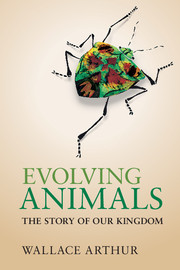Book contents
- Frontmatter
- Dedication
- Contents
- Preface
- Acknowledgements
- 1 What is an animal?
- 2 Before there were animals
- 3 How to make a fossil
- 4 The Cambrian explosion
- 5 How to make a species
- 6 Jellyfish and their kin
- 7 How to make a tree
- 8 The enigmatic urbilaterian
- 9 Animal symmetry and heads
- 10 A plethora of worms
- 11 Trends in animal complexity
- 12 Where the octopus is king
- 13 How to make an animal
- 14 Exoskeletons galore
- 15 Extinction
- 16 Mouth first, mouth second
- 17 Comparing embryos
- 18 Larvae, mouthparts and moulting
- 19 The animal toolkit
- 20 Vertebrate origins and evolution
- 21 From water to land to water
- 22 Variation and inheritance
- 23 Evolutionary novelties
- 24 Human origins and evolution
- 25 Animal plasticity
- 26 The nature of adaptation
- 27 The direction of evolution
- 28 Animal extremophiles
- 29 Extraterrestrial animals?
- 30 The ghost in the machine
- Appendix
- References
- Index
Preface
Published online by Cambridge University Press: 05 August 2014
- Frontmatter
- Dedication
- Contents
- Preface
- Acknowledgements
- 1 What is an animal?
- 2 Before there were animals
- 3 How to make a fossil
- 4 The Cambrian explosion
- 5 How to make a species
- 6 Jellyfish and their kin
- 7 How to make a tree
- 8 The enigmatic urbilaterian
- 9 Animal symmetry and heads
- 10 A plethora of worms
- 11 Trends in animal complexity
- 12 Where the octopus is king
- 13 How to make an animal
- 14 Exoskeletons galore
- 15 Extinction
- 16 Mouth first, mouth second
- 17 Comparing embryos
- 18 Larvae, mouthparts and moulting
- 19 The animal toolkit
- 20 Vertebrate origins and evolution
- 21 From water to land to water
- 22 Variation and inheritance
- 23 Evolutionary novelties
- 24 Human origins and evolution
- 25 Animal plasticity
- 26 The nature of adaptation
- 27 The direction of evolution
- 28 Animal extremophiles
- 29 Extraterrestrial animals?
- 30 The ghost in the machine
- Appendix
- References
- Index
Summary
When our planet was only half its current age it was already teeming with life, yet not a single animal swam in its oceans, walked on its land, or flew in its skies. Now, in contrast, there are well over a million known species of animals on Earth. Sometime in between, the very first animal arose from a unicellular ancestor. This animal was probably a tiny marine creature whose body consisted of just a handful of cells. One way of looking at the animal kingdom is as a vast number of lines of descent – or lineages – radiating out through time from that original animal, with each lineage either terminating in an extinction or continuing to evolve today.
Each line of descent has its own story to tell. So the story of the animal kingdom is a composite one, with many subplots being played out in individual lineages. In between a single lineage and our whole kingdom lie the stories of particular animal groups. In this book, I try to tell some of the individual stories, notably the human one, and some of the group stories, for example those of the three biggest groups of animals (the arthropods, the molluscs and the vertebrates). From these accounts, the composite story of the animal kingdom gradually emerges.
- Type
- Chapter
- Information
- Evolving AnimalsThe Story of our Kingdom, pp. ix - xPublisher: Cambridge University PressPrint publication year: 2014



